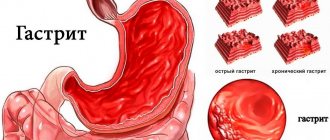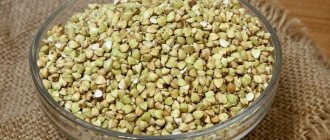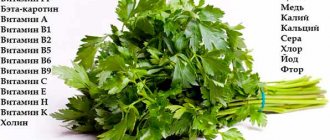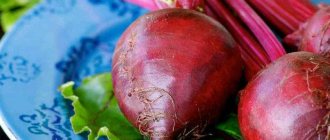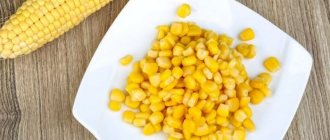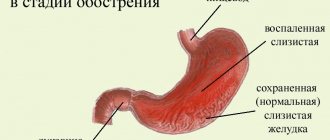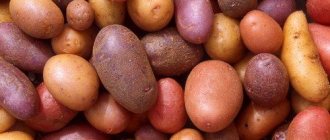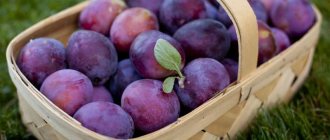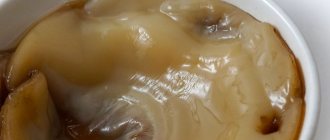Treatment of pancreatitis is always accompanied by adherence to a strict diet. The difficulty of creating a daily menu is that it must include not only safe, but also healthy products. To restore the functioning of the digestive system, various microelements and vitamins are no less important; at the same time, food should not contain fiber and coarse fibers, which are difficult to digest by the gastrointestinal tract.
Nutritionists allow adding cauliflower to the diet if the pancreas malfunctions only after special cooking and as part of other dishes. To prevent this vegetable from leading to intestinal overload, a certain dosage must be observed.
Benefits of cauliflower
When diagnosing pancreatitis, adherence to a certain diet is inevitable. In the acute phase, it is very important to reduce the load on the pancreas. In this regard, the patient’s diet should include easily digestible foods with low fiber content.
Many patients doubt whether it is possible to eat cabbage with pancreatitis, as they assume that such a vegetable can cause painful flatulence in the intestines. But, as it turned out, this opinion is considered erroneous, and there is reasoned confirmation of this.
Cauliflower is quite often included in dishes that are recommended for pancreatitis, gastritis, liver damage, and peptic ulcers. This vegetable is a supplier of vitamins A and C, contains large amounts of iron, potassium, magnesium, as well as various acids and pectin. Cauliflower also contains valuable vitamin U, which:
- neutralizes toxins and reduces their levels in the body;
- normalizes acidity levels;
- activates metabolic processes;
- reduces the likelihood of constipation.
In addition, scientists have proven the antitumor effect of cauliflower, as well as its participation in reducing cholesterol levels in blood vessels.
Benefits and harms in case of illness
In case of pancreatitis, doctors exclude all foods containing fiber from the patient’s diet. Cauliflower contains a small amount of this substance, which is why it is indicated for problems with the gastrointestinal tract.
For pancreatitis, doctors prescribe the use of cauliflower, since the vegetable is low in calories and has many beneficial properties. The product is a leader in the content of nutrients and vitamins A, C, pectin, iron, potassium, magnesium and various acids. Thanks to vitamin U, the vegetable has a beneficial effect on the body:
- cleanses of impurities and toxins;
- fills with vegetable protein;
- normalizes stomach acidity;
- improves metabolism;
- adjusts intestinal motility and relieves constipation.
Cauliflower is useful for the prevention of tumor diseases and helps cleanse blood vessels of cholesterol.
In what form can the vegetable be consumed?
Cauliflower for pancreatitis should be consumed in strictly limited quantities and only after heat treatment. Nutritionists do not recommend eating this vegetable as a separate dish. Cauliflower should be added to soups, casseroles, and vegetable stews in a puree form.
In case of chronic pancreatitis or during an exacerbation of the disease, the vegetable should be introduced into the diet in small doses. It is important to carefully monitor the body’s reaction. There are cases when the patient experiences colic, bloating and nausea. If such symptoms appear, cauliflower should be immediately excluded from the diet.
The daily intake of cauliflower should be no more than 100 g, and we are talking only about boiled vegetables. Fried and baked cabbage is not allowed to be consumed if the functionality of the pancreas is impaired. Quite often, cauliflower is steamed. This cooking method allows you to preserve maximum nutrients in the product. Also, during steam treatment, the amount of essential oil decreases.
Useful recommendations for use
Some people don't like the taste of the vegetable. It's hard to blame them. And maybe they just haven’t found a dish that suits them.
Since fried options are prohibited for you if you have diseases of the gastrointestinal tract and pancreas, try implementing the following ideas:
- use a food processor to turn the cabbage into "rice". Turn it on jerkily, chopping the vegetable to the desired size of pieces. Thanks to the olive oil and onions, this preparation will become a staple for any dishes that you eat with rice. And at the same time, the dish contains only ¼ of the amount of carbohydrates contained in real rice;
- whisk it like a sauce. But be sure to use skim milk and low-fat sour cream to keep calories in check;
- Mash it with low-fat Greek yogurt and grated Parmesan until you get a nice puree.
Include cauliflower in your diet. But any food in large quantities can be harmful, so try to consume everything in moderation.
Recipes for pancreatitis
In dietary cooking, you can use fresh or frozen cabbage. When choosing a vegetable, you should give preference to white inflorescences. If there are black specks on the vegetable, this indicates that the cabbage has been stored for a long time and may have lost a number of useful microelements.
Before cooking the head of cabbage, small inflorescences are disassembled. To give the product a whiter color, add a little sugar to the boiling water. Young heads of cabbage are cooked for no more than 10-15 minutes. The finished product should be easy to prick with a fork.
When is its consumption not recommended?
Despite the fact that cauliflower is considered a dietary product and contains useful substances and vitamins, it is not recommended to use the product if the patient has an allergic reaction. This reaction can occur especially with inflammation of the pancreas. Allergies are revealed by nausea, vomiting, colic, and increased body temperature.
Cauliflower is also not recommended for use if:
- Exacerbation of pancreatitis, gastritis, cholecystitis;
- Increased stomach acidity;
- Gout;
- Intestinal cramps;
- Hypertension;
- Postoperative period, if the sutures are in the chest and abdominal area;
- Kidney problems.
Cauliflower soup with chicken
This dish is high in protein, has a delicate consistency and is easily digestible by the gastrointestinal tract.
To prepare the soup you will need:
- chicken breast – 0.5 kg;
- potatoes – 2 pcs.;
- carrots – 1 pc.;
- cauliflower – 6 large inflorescences;
- salt.
First of all, you need to cook the chicken meat. To do this, fill the breast with water and place it on the stove. After the broth boils, you need to drain it, rinse the meat, add cold water again and boil. After 30 minutes, the meat must be removed from the broth and minced twice.
Add prepared vegetables to the hot broth, add salt and cook until fully cooked. The ratio of vegetable mass and water should be the same. After all the ingredients become soft, they need to be cooled a little and blended with a blender. Add minced chicken to the resulting mass. Before serving, add a little sour cream to the serving.
What not to do
Not only in the acute stage, but also in the chronic form of pancreatitis, fried, pickled, fatty, spicy and smoked foods must be excluded from the diet. Such food stimulates the gland, increasing the production of pancreatic juice.
Important! It is necessary to completely give up alcohol.
It is necessary to completely exclude:
- Bakery products, confectionery products, fresh baked goods.
- Strong meat, fish and mushroom broths, soups using them.
- Soups made from legumes, with the addition of millet, dishes with a sour taste, for example, rassolnik.
- Pork, goose, duck, offal.
- Canned fish.
- Boiled and fried eggs.
- Hard cheeses, whole milk, full-fat dairy products.
- Marinades and pickled vegetables.
- Sorrel, spinach, turnips, garlic, radishes, turnips, onions, fresh cucumbers, bell peppers, mushrooms.
- Pasta.
- Fresh fruits and berries.
- Barley and egg.
Cauliflower Casserole
This recipe is quite easy to prepare and contains only approved ingredients. To prepare it you will need:
- cauliflower – 300 g;
- carrots – 1 pc.;
- wheat crackers – 15-20 g;
- milk – 50 ml;
- egg – 1 pc.;
- a little hard cheese;
- butter – 5 g.
Cauliflower inflorescences need to be boiled in salted water. Then the vegetable needs to be cut into small pieces. Next, you need to boil the carrots in the remaining broth and then grate them on a coarse grater. Soak wheat crackers in milk.
To prepare the filling, you need to beat the white and grind the yolk with butter. Then combine the ingredients and add grated cheese to the mixture. Salt the mixture to taste.
Mix the vegetables with the soaked breadcrumbs and spread the whole mass on a baking sheet with high sides. Then pour the egg mixture over the dish and place in the oven for 20 minutes. The baking temperature should be no more than 200⁰C.
What is possible
What can you eat if you have pancreatitis? After the symptoms subside, the following products are allowed to be included in the menu:
Nutrition for cholecystitis and pancreatitis
- Homemade crackers, biscuits.
- Slimy soups cooked in water or vegetable broth. Thoroughly boiled and pureed cereals are used for thickening. Cream soups with the addition of pureed meat of dietary varieties are allowed.
- Dietary meat: chicken, rabbit, beef, turkey. The skin must be removed from them and all cartilage removed. A steamer is used to cook meat. Allowed meat dishes: meatballs, meatballs, soufflé.
- Low-fat fish: hake, pike perch.
- Yolkless steam omelette or just boiled egg white.
- Fresh kefir with a minimum percentage of fat content, homemade yoghurts.
- Low-fat cottage cheese. You can use it to make casseroles and prepare mousses.
- Milk is used only as a base when cooking cereal soups.
- Butter is introduced into the menu on the 10th day after the attack of acute pancreatitis has stopped. The daily norm is no more than a teaspoon.
- Cauliflower, carrots, zucchini, potatoes. They are first boiled, then pureed or thoroughly ground. They can be added little by little to soups.
- Porridge. After the exacerbation is relieved, you can cook thoroughly boiled oatmeal, buckwheat and rice.
- Baked apples.
- Kissels, jellies, mousses made from sweet berries and fruits. Instead of granulated sugar, you need to use honey.
Allowed drinks: weakly brewed green tea, black tea, herbal drinks, cranberry/lingonberry fruit drinks, rosehip berry decoctions. During the day you need to drink at least two liters of clean water.
Weekly menu
The diet involves a gradual expansion of the diet. We offer you a sample menu for a week for pancreatitis, which can be used after eliminating the main symptoms of the attack. All dishes during this period are served pureed.
Monday:
- Breakfast – buckwheat with milk, cottage cheese soufflé, drink.
- Second breakfast – apples with honey, spotted in the oven, and carrot juice.
- Lunch – vegetable soup thickened with semolina, cutlets with vegetable puree (squash and potatoes), compote.
- Afternoon snack – tea and biscuits.
- Dinner – steamed protein omelette, oatmeal, tea.
Tuesday:
- Breakfast - rice porridge, cottage cheese with fruit gravy, drink.
- Second breakfast - allowed fruit baked in the oven.
- Lunch – buckwheat soup with grated carrots, chicken dumplings garnished with vegetable puree, jelly.
- Afternoon snack – egg white omelet, juice.
- Dinner – mashed potatoes with a piece of steamed fish, a drink.
Wednesday:
- Breakfast – rice porridge with milk, steamed omelette, drink.
- Second breakfast - a portion of cottage cheese, topped with jam.
- Lunch – creamy zucchini soup, buckwheat porridge with steamed chicken, drink.
- Afternoon snack – banana.
- Dinner – steamed fish cutlets with vegetable puree, biscuits, drink.
Thursday:
- Breakfast – buckwheat spread with milk, steamed omelette, a piece of cheese, a drink.
- Second breakfast - meat soufflé.
- Lunch – vegetable soup with meatballs, beef roll, garnished with omelette, grated carrot salad seasoned with vegetable oil, drink.
- Afternoon snack – cottage cheese pudding.
- Dinner – mashed potatoes with boiled fish, poured with milk sauce, drink.
Friday:
- Breakfast – pureed oatmeal with milk, cottage cheese with a spoonful of fruit jam, a drink.
- Second breakfast – steamed omelette, drink.
- Lunch – vegetable soup with sour cream, meat gravy with mashed potatoes, drink.
- Afternoon snack – jelly with biscuits or homemade crackers.
- Dinner – rice porridge with a piece of steamed fish, vegetable salad, drink.
Saturday:
- Breakfast – buckwheat spread with milk, a portion of cottage cheese, topped with jam, tea.
- Second breakfast - protein omelet, rosehip decoction.
- Lunch – milk soup, meat cutlets (steamed), garnished with rice porridge, drink.
- Afternoon snack – minced chicken dumplings.
- Dinner – fish cutlets with vegetable puree, drink.
Sunday:
- Breakfast – semolina pudding with sweet gravy, steamed omelet, drink.
- Second breakfast – cottage cheese, juice.
- Lunch – cereal vegetable soup, chicken soufflé, drink.
- Afternoon snack – jelly with biscuits.
- Dinner – steamed minced fish cutlets with rice porridge, drink.
Allowed drinks: sweet fruit juice, tea with milk or honey, compote, rose hip drink. At night - kefir. This weekly menu option can be practiced in childhood.
